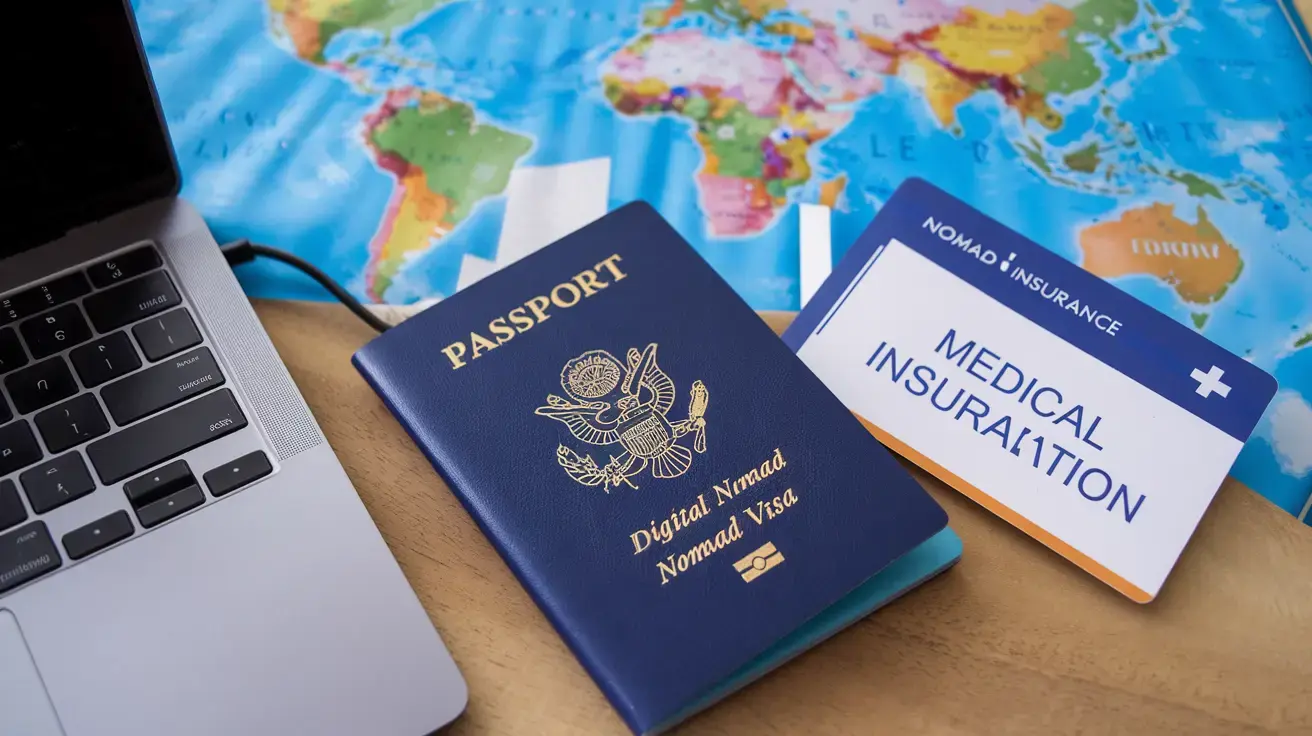Best Financial Planning for Remote Workers
Living the digital nomad dream that so many aspire to. But behind those Instagram-worthy moments lies a complex financial reality that many remote workers are unprepared to navigate. As of June 2025, managing your finances across borders has become both easier with technology and more complicated with evolving regulations.
The freedom of location-independent work comes with unique financial challenges: income that fluctuates month to month, tax obligations in multiple countries, currency exchange headaches, and the constant question of “what if something goes wrong?” For American digital nomads especially, the maze of worldwide income reporting requirements and foreign tax considerations can turn your dream lifestyle into a financial nightmare if not properly managed.
The good news? With strategic planning, you can build a financial foundation that supports your borderless lifestyle rather than restricting it.
In this guide, we’ll explore how to create a truly nomadic financial system that works wherever you roam. From establishing a flexible budget that accommodates your variable income and unpredictable expenses, to optimizing your tax strategy with tools like the Foreign Earned Income Exclusion, to smart currency management that saves you thousands annually.
We’ll also dive into maintaining investment growth while abroad and building the safety nets every digital nomad needs – because financial freedom is what allows your geographical freedom to flourish. 💼✈️
Creating a Flexible Budget for Variable Income
A. Establishing a baseline using lowest monthly income from past two years
Living the digital nomad life means dealing with income that’s all over the place. One month you’re flush with cash, the next you’re wondering if you can afford that cute café with decent WiFi.
The solution? Go back through your last 24 months of income and find your lowest-earning month. That’s your baseline. That’s what you build your essential budget around.
Why this works: When you know you can cover your basics even in your worst month, everything else becomes a bonus. It’s about peace of mind while you’re exploring Bali or working from a co-living space in Lisbon.
Quick steps to establish your baseline:
- Pull your income statements for the past two years
- Identify your three lowest-earning months
- Average them out (or just use the absolute lowest if you want to be extra cautious)
- Build your “must-have” budget using this number
Got wildly irregular income? I’ve been there. Try creating a “minimum viable lifestyle” budget—just the essentials that keep you working and healthy. For me, that’s accommodation, internet, food, health insurance, and enough for a decent coffee daily. Everything beyond that goes into different tiers of “nice-to-haves.”
B. Planning for unforeseen costs and fluctuating living expenses
The unpredictable life demands an unpredictable budget. When you’re hopping between Thailand one month and Switzerland the next, your cost of living doesn’t just change—it transforms completely.
Smart nomads build buffers into their budgets. I recommend a three-part approach:
Location Adjustment Fund
Create a quick reference chart of your potential destinations and their relative costs. If moving from Chiang Mai to Copenhagen, you might need 3x your monthly expenses ready to go.
The “Stuff Happens” Fund
This isn’t just your emergency fund (though you absolutely need one of those too—aim for 6-9 months of expenses). This is smaller, more accessible money for when your laptop dies, you need a last-minute flight change, or you discover your Airbnb is nothing like the photos.
Set aside 10-15% of your monthly income specifically for these not-quite-emergencies. They happen more often on the road than at home.
Seasonal Planning
Remote work often has seasonal fluctuations. Map out your historically busy and slow months against your travel plans. Save during high-income periods to subsidize the valleys. Never book expensive destinations during traditionally slow income months.
C. Tracking expenses across different currencies
Currency chaos is a headache most digital nomads know too well. Here’s how to tame the multi-currency beast:
Pick Your “Home” Currency
Choose one currency for tracking everything—usually your billing currency or where you pay taxes. This gives you a consistent measuring stick.
Use the Right Tools
Forget spreadsheets. They’ll drive you crazy with constant conversions. Instead:
- Expense trackers with multi-currency features: Apps like Toshl or TravelSpend let you record expenses in local currency but report in your home currency
- Banking solutions: Wise (formerly TransferWise) or Revolut offer virtual accounts in multiple currencies with excellent exchange rates
- Receipt capture: Use apps that scan receipts and automatically detect currencies
Exchange Rate Strategy
Don’t just accept whatever rate you get on any given day. Create a system:
- Set a monthly “accounting day” where you convert all expenses using the same exchange rate
- For major expenses (like rent), note both the local amount and your home currency equivalent when you pay
- Build in a 3-5% buffer when planning expenses in foreign currencies to account for exchange rate fluctuations
The Nomad’s Currency Calendar
Create a simple calendar marking days when you’ll move significant money between currencies. Watch exchange rate trends and try to time these transfers when rates are favorable—it can save you hundreds over a year.
The best trackers don’t just record what you spent but tell you what things actually cost in terms you understand. “That fancy dinner was equal to 3 days of accommodation in Bali” hits differently than just seeing the dollar amount.
Understanding Tax Obligations as a Digital Nomad
A. U.S. tax reporting requirements for worldwide income
Living the digital nomad dream doesn’t mean escaping Uncle Sam’s reach. As a U.S. citizen or permanent resident, you’re on the hook for taxes on your worldwide income, no matter where you’re sipping coconuts or tapping keyboards.
The IRS doesn’t care if you’re coding from Bali or consulting from Barcelona – you still need to file that annual tax return by April 15th (or June 15th if you’re physically abroad on the regular deadline).
What counts as taxable income? Pretty much everything:
- Your remote salary
- Freelance gigs and side hustles
- Investment dividends
- Rental income from that apartment you’re subletting back home
- Even crypto gains (yes, they’re watching that too)
Many digital nomads mess up by thinking “out of sight, out of mind” applies to taxes. It doesn’t. Skipping your U.S. tax filing can lead to nasty penalties, interest charges, and even passport revocation in serious cases.
Pro tip: The $10,000+ foreign bank account threshold triggers FBAR filing requirements. Miss this, and penalties start at $10,000 for non-willful violations. Yikes!
B. Leveraging the Foreign Earned Income Exclusion
The Foreign Earned Income Exclusion (FEIE) is your golden ticket to potentially excluding up to $126,500 (for 2025) of your foreign earnings from U.S. taxes. This isn’t just nice – it’s a game-changer for your nomad finances.
To qualify, you need to pass either:
- The Physical Presence Test: Be physically present in foreign countries for at least 330 full days during a 12-month period.
- The Bona Fide Residence Test: Establish a “tax home” outside the U.S. and genuine residence in a foreign country for an uninterrupted period including an entire tax year.
The tricky part? The FEIE only applies to earned income – that’s money from actual work. Passive income like investments, rental properties, or pensions don’t count. And you can’t exclude income earned while physically working in the U.S., even for a foreign employer.
Many nomads strategically plan their U.S. visits to stay under the 35-day limit and maintain FEIE eligibility. Those calendar alerts tracking your days abroad? Worth every annoying notification.
Remember to file Form 2555 with your tax return to claim this exclusion. Miss it, and you’re leaving serious money on the table.
C. Managing foreign tax obligations and avoiding double taxation
Nobody wants to pay taxes twice on the same income. That’s just cruel. Yet as a digital nomad, you might face tax obligations in multiple countries simultaneously.
The U.S. has tax treaties with over 60 countries designed to prevent double taxation. These agreements determine which country has primary taxing rights and which must provide relief.
Your main weapons against double taxation are:
Foreign Tax Credit (FTC): This dollar-for-dollar credit reduces your U.S. tax liability based on income taxes paid to foreign countries. File Form 1116 to claim it.
Tax Treaties: These can reduce or eliminate taxes on certain types of income in treaty countries. Digital nomads often leverage these for things like royalties, dividends, and sometimes even self-employment income.
The taxation headache gets more complex depending on:
- How long you stay in each country
- Whether you’re an employee or self-employed
- If you establish tax residency elsewhere
Some countries like Thailand or Malaysia might ignore your income if it’s paid into a foreign bank account. Others like Portugal offer special tax regimes for digital nomads. And a few tax havens charge zero income tax altogether.
But tread carefully – tax avoidance (legal) can easily slip into tax evasion (illegal) territory. The smart move? Get professional advice tailored to your specific situation and destinations.
Optimizing Currency Management and Transfers
Currency management can make or break your financial stability as a digital nomad. I’ve seen remote workers lose thousands simply by using the wrong services. Let’s fix that.
A. Comparing online transfer services like Wise
Wise (formerly TransferWise) changed the game for nomads, but it’s not the only player worth considering:
| Service | Pros | Cons | Best For |
|---|---|---|---|
| Wise | Mid-market rates, transparent fees, multi-currency accounts | Not available in all countries | Regular transfers, holding multiple currencies |
| Revolut | Free currency exchange up to limits, virtual cards | Weekend surcharges, premium features require subscription | Everyday spending, smaller transfers |
| PayPal | Widely accepted, instant transfers | High conversion fees (4-5%), poor exchange rates | Client payments when no alternative exists |
| OFX | Better rates for large transfers, personal account manager | Higher minimum transfers, slower processing | Moving $5,000+ between countries |
The difference between these services can be hundreds of dollars monthly. Most digital nomads I know use Wise as their primary service and keep a backup option like Revolut for emergencies.
B. Working with foreign exchange brokers for large transfers
Moving serious money? Online services aren’t always your best bet. Foreign exchange brokers shine when transferring over $10,000:
Foreign exchange brokers like Currencies Direct, World First, and TorFX offer:
- Personalized service with dedicated account managers
- Better rates for larger sums (sometimes 3-4% better than banks)
- Forward contracts to lock in rates for future transfers
- Guidance on timing transfers for favorable market conditions
The catch? You’ll need to verify your identity thoroughly and sometimes explain the source of funds. Worth it for the savings on major transfers like property purchases or investments.
C. Minimizing currency conversion fees and exchange rate losses
Currency leakage is the silent killer of nomad finances. Here’s how to plug those holes:
- Batch your transfers – Convert larger amounts less frequently instead of many small conversions
- Watch the timing – Currency markets fluctuate daily; use apps like XE to track favorable rates
- Get paid in strong currencies when possible (USD, EUR, GBP)
- Use local bank accounts in countries where you spend significant time
- Choose credit cards with no foreign transaction fees like Chase Sapphire or Capital One Venture
- Avoid airport currency exchanges and hotel conversion services like the plague
Smart nomads maintain a “currency strategy” document outlining which accounts and cards to use in each country. This alone can save you 5-8% of your income annually.
Maintaining and Growing Investments While Abroad
Accessing U.S. Investment Accounts from Overseas
The freedom of working remotely while sipping coconut water on a Thai beach is incredible—until you need to rebalance your portfolio and discover your brokerage has locked you out.
Here’s the deal: many U.S. investment platforms get nervous when they detect foreign IP addresses. Charles Schwab and Fidelity tend to be more digital nomad-friendly, while smaller platforms might freeze faster than your laptop in an Icelandic coffee shop.
Solutions that actually work:
- VPN services with U.S. servers (NordVPN and ExpressVPN have solid reputations)
- Two-factor authentication setup before leaving the States
- Written confirmation from your brokerage about their overseas access policies
- Setting up a trusted contact in the U.S. who can make emergency transactions
Remember to notify your investment platforms before heading abroad. That five-minute phone call can save weeks of financial headaches down the road.
Working with Financial Advisors Specializing in Expat Finances
Finding a financial advisor who understands the digital nomad lifestyle is like finding reliable WiFi in a remote village—rare but absolutely worth the search.
The right advisor isn’t just someone with fancy credentials. You need someone who:
- Has experience with cross-border taxation (this is non-negotiable)
- Understands investment restrictions for Americans abroad
- Can navigate Foreign Account Tax Compliance Act (FATCA) requirements
- Communicates during hours that work with your time zone
Virtual advisors are increasingly catering to location-independent professionals. Many offer Zoom consultations and digital document signing, making the entire process remote-friendly.
Before committing, ask potential advisors about their experience with clients in your specific situation. Someone who works primarily with retirees in Panama might not be ideal for a 30-something programmer bouncing between Bali and Berlin.
Long-term Investment Strategies for Location-Independent Professionals
The location-independent lifestyle doesn’t mean your investments should be equally untethered. In fact, the unpredictability of remote work income makes solid investment planning even more crucial.
Smart strategies when your address changes more than your passwords:
- Build a globally diversified portfolio: Currency fluctuations can hit hard when your income is in one currency but your expenses in another. Spreading investments across markets provides natural hedging.
- Embrace passive income: Dividend-paying stocks and REITs can create income streams that flow regardless of where you’re sleeping tonight.
- Consider retirement account complexities: Contributing to Roth IRAs can be tricky with the Foreign Earned Income Exclusion. Some digital nomads strategically return to the U.S. briefly to make qualified contributions.
- Stay liquid but not too liquid: Keep enough cash accessible in multiple currencies for emergencies, but not so much that inflation erodes your savings.
The best investment approach combines the freedom you cherish with the stability your future requires. That means automation—set up regular investments that happen whether you’re answering emails from a hammock or scaling a mountain with no signal.
Building Financial Safety Nets
A. Establishing a 3-6 Month Emergency Fund for Income Fluctuations
The nomad life is amazing until you hit a dry spell. Trust me, I’ve been there.
One minute you’re working poolside in Bali, the next you’re frantically checking your account balance because a client ghosted you. Income hiccups are the uninvited guests of remote work life.
That’s why smart digital nomads build a buffer – a 3-6 month emergency fund that acts as your personal safety net. This isn’t just some financial guru advice; it’s survival gear for the location-independent lifestyle.
How much should you save? Take your monthly essential expenses (housing, food, insurance, WiFi) and multiply by at least three. For most nomads, that’s somewhere between $6,000-$15,000 depending on your travel style.
Store this fund in a high-yield savings account that you can access globally but isn’t connected to your daily spending card. Think of it as your “break glass in case of emergency” money.
Pro tip: Build this fund before you even board that first plane. Working frantically to cover basics while dealing with unstable WiFi in a foreign country is a nightmare I wouldn’t wish on anyone.
B. Securing Comprehensive Global Health Insurance Coverage
Getting sick abroad without insurance is a financial horror story waiting to happen.
A simple hospital stay in places like Singapore or Switzerland can cost thousands per day. Even in “cheap” countries, quality healthcare for serious issues isn’t budget-friendly.
Global health insurance for remote workers typically comes in three flavors:
| Insurance Type | Coverage | Best For |
|---|---|---|
| Travel Insurance | Short-term emergency coverage | Brief trips, basic protection |
| Expat Insurance | Comprehensive coverage in specific regions | Staying in one region |
| Global Health Insurance | Worldwide coverage including evacuation | True digital nomads |
Look for policies that offer:
- Medical evacuation (crucial if you’re working from remote areas)
- Coverage without requiring a home country return
- Direct billing with hospitals
- Telehealth options
Companies like SafetyWing, World Nomads, and Cigna Global have created products specifically for our lifestyle. Yes, premiums can seem steep ($100-400/month), but compare that to a $20,000 emergency appendectomy in a private hospital.
C. Planning for Unexpected Repatriation or Relocation Costs
The pandemic taught nomads a brutal lesson: sometimes you need to pack up and leave – fast.
Whether it’s a family emergency, political unrest, natural disaster, or another global crisis, having a rapid exit strategy isn’t paranoid – it’s prudent.
Your repatriation fund should cover:
- Last-minute one-way flights (often 3-5x normal prices during emergencies)
- Temporary accommodation upon arrival
- Transport of essential belongings
- Buffer for settling back in
Keep at least $2,000-$3,000 accessible specifically for these scenarios. Consider stashing some in different formats – part in a digital account, part as cash in major currencies, and maybe even a bit in cryptocurrency for truly desperate situations.
Don’t forget about the mental preparation too. Keep digital copies of all important documents in encrypted cloud storage, maintain a current list of emergency contacts, and always know where your nearest embassy is located.
The freedom of nomad life comes with responsibility. When things go sideways – and eventually, something will – having these financial safety nets means you can focus on solving problems rather than spiraling into panic.
Conclusion
Navigating financial planning as a remote worker or digital nomad requires strategic thinking and adaptability. From establishing a flexible budget based on your lowest expected income to understanding complex tax obligations across borders, your financial foundation must be both sturdy and nimble. Currency management, maintaining investment growth, and building proper safety nets—including emergency funds and comprehensive health insurance—are not just recommendations but necessities in this lifestyle.
The freedom of location independence comes with unique financial responsibilities that traditional workers don’t face. By taking a proactive approach to your finances and seeking guidance from professionals who understand the intricacies of expatriate financial planning, you can enjoy your borderless lifestyle while ensuring long-term financial stability.
Remember that your financial strategy should evolve as your journey continues—what works in one country or life stage may need adjustment in the next. With thoughtful planning, you can transform the potential challenges of remote work into opportunities for financial growth and security, no matter where your adventures take you.











